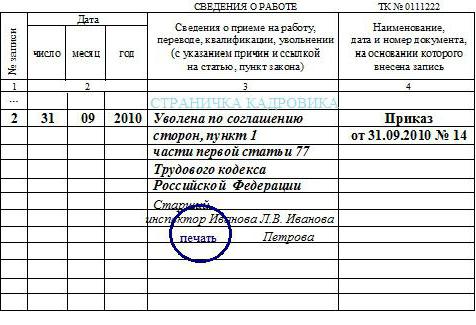Today we have to find out what are the pros and cons of dismissal by agreement of the parties. In real life, such a process of dismissing an employee does not occur too often, but it is provided for by labor law. What features of the procedure are worth paying attention to? What advantages and disadvantages does this solution have? The answers to these questions and not only will certainly be found below. In fact, understanding all of this is much easier than it sounds. Especially to the staff. This operation requires almost nothing from them.

What is meant
What is provided for by Art. 78 of the Labor Code of the Russian Federation? This article indicates the possibility of dismissal of employees by agreement of the parties. The employee and the employer agree among themselves on the termination of the employment relationship.
According to the actions, the mentioned operation is no different from the situation when a person leaves his own free will. Ultimately, a citizen without scandals and negative consequences will be dismissed from his previous job.
Some kind of agreement between the bosses and the employee is one of the options for resolving conflicts related to the termination of the labor type agreement. This situation has its pros and cons. About them will be discussed later.
Special moments
To begin, consider one important feature of the operation under study. The dismissal of an employee by agreement of the parties is a means of terminating labor-type relationships with pregnant women and with mothers on maternity leave.
In general, in Russia, pregnant and new mothers are protected by labor law. The employer himself almost never can dismiss the listed employees. Dismissal of a subordinate is allowed only in a few cases:
- by agreement of the parties;
- at the request of the employee;
- in connection with the liquidation of IP;
- upon expiration of the current fixed-term employment contract.
It follows that the studied pattern of actions helps pregnant and newly-born women to agree with the employer on dismissal. For companies, this scenario is very attractive.

Initiators
Who can initiate the process? In Art. 78 of the Labor Code of the Russian Federation, it is indicated that, with the agreement of the parties, both the employee (which is rare) and the boss have the right to make the corresponding proposal.
For subordinates, the procedure for terminating relations will remain the same. Citizens submit a letter of resignation and await the decision of the employer.
But if the initiator of the termination of relations is the boss, you will have to follow a certain procedure. The main step is to send an alert with a letter of resignation.
If the employee does not agree to leave work, you can send the appropriate letter to the employer. This means that termination of employment by agreement of the parties will not take place. Experts recommend solving such issues in advance.
Agreement form
An application for dismissal by agreement of the parties in the Labor Law does not have specific forms. The main requirement is to submit the document in writing.

The rest of the application is written at the discretion of the initiator of the termination of the relationship. For example, the following data may be published in it:
- information about the parties to the process;
- details of the contract;
- term of the alleged dismissal;
- the conditions that must be met at the time the employee leaves work;
- agreement on the financial side of the issue;
- signatures of the employer and employee;
- other conditions and important points for termination of the contract.
Accordingly, the exact form of a letter of resignation by agreement of the parties cannot be seen. Each document will be unique and original. The only thing that should be taken into account is that when drawing up a document, it is necessary to follow the generally accepted rules by which business correspondence is conducted.
pros
Next, we will consider the pros and cons of dismissal by agreement of the parties. There are more than enough of them. Let's start with the positive aspects of the chosen form of leaving work.
The benefits of termination by agreement with the employer include the following:
- No need to indicate the reason for the desire to quit the organization. An employee can simply write something like "According to Article 78 of the Labor Code of the Russian Federation, I ask for dismissal."
- An agreement between subordinates and superiors can be achieved both in writing and orally.
- There are no deadlines for leaving work.
- The initiator of the proposal, as we have already found out, has the right to act both employees and employers.
- A letter of resignation will not affect a career.
- After the termination of the relationship, a person will be credited with an additional month of work experience. It is a continuous period of labor.
- Allowed to quit in this way at any time. Even with a trial period, the parties are able to agree to terminate the relationship.
- Unemployment benefits will be paid in larger amounts than upon dismissal of their own free will.
- There is a chance to reach an agreement on financial matters. For example, regarding the amount of benefits and compensation that will be given to a subordinate upon dismissal.
It would seem that this scenario is suitable for dissolution of labor-type relations most of all. But in reality, everything is not as rosy as we would like. Dismissal by agreement of the parties has pros and cons in large numbers. What are the disadvantages of such a procedure?

About cons
They are not so few. And mostly the shortcomings relate to employees. For employers, the disadvantages of termination will be considered pluses.
Please note:
- Dismissal by agreement of the parties leads to the fact that the employee can be fired, even if he is on vacation.
- It is not possible to withdraw the agreement unilaterally. To do this, both parties must approve the operation.
- It will not work to challenge dismissal actions in court or in the Labor Inspectorate.
- There are no guarantees to receive compensation if they are not mentioned in the agreement.
- The legitimacy of actions by unions is not controlled in any way.
Based on the foregoing, it turns out that the dismissal by agreement of the parties (the pros and cons of this act we studied) is more suitable for employers. But workers can also benefit from certain benefits.
About Payments
The financial side of the issue plays a huge role in the issue under study. Payments upon termination by agreement of the parties are not mandatory. This means that citizens can not always rely on the material support of the employer at the time of leaving work.
Nevertheless, this does not mean that the employee risks being left with nothing. According to the Labor Code of the Russian Federation, dismissal by agreement of the parties in Russia provides for a number of standard payments upon termination of the labor type agreement.
These include:
- compensation for the vacation, if the employee did not visit it;
- money for hours worked.
If the subordinate took the leave in advance, then the amount of the “loan” will have to be deducted from the salary and payments for the days worked before dismissal. This is a legitimate practice.
All other compensations (compensation) will have to be agreed. All features of payments must be indicated in the agreement on termination by mutual agreement.Otherwise, the citizen runs the risk of being left with minimal finances.
Step by Step Actions
And how does the dismissal occur by agreement of the parties? The pros and cons of this procedure are already known to us. But what's next? What to do if you want to quit under the article mentioned earlier?
It is recommended to follow the instructions:
- Make a letter of resignation. It needs to spell out all the features of concluding an agreement.
- Notify the employer / employee of their decision.
- Issue a dismissal order and sign it.
- To familiarize the subordinate with the order.
- Make an appropriate entry in the employee’s workbook and mark the employee’s personal card.
- Issue a check sheet, income statement and work book.
- Get the required cash, which the parties agreed on.
- Sign for the calculation and received documents in special accounting journals.
- Notify the military enlistment office of the dismissal. This step is required only when it comes to the dismissal of men.
That's all. It would seem that there is nothing difficult or incomprehensible in this. But in fact, the termination of the employment contract by agreement of the parties (the advantages of the operation are already known to us) is a rare and very confusing process. Especially if the initiator of the dismissal is the boss. Under such circumstances, as already mentioned, subordinates are protected to a minimum.
About the labor exchange
Some cadres prefer to enter the labor exchange after dismissal by agreement of the parties. Not the most common, but taking place in practice, phenomenon.
The thing is that if the termination of the labor type agreement occurs by mutual agreement, the employee can hope for an increased unemployment benefit. For this reason, some are interested in the studied procedure.
At the same time, it will have to be taken into account that in terms of other payments, the employee is not protected in any way. That is, compensation for him was not originally laid. And the increased unemployment benefit is often less than the benefits guaranteed by ordinary dismissal.
Controversial issues
Now a little about what controversial situations may arise in the situation under study. As we have already found out, a record of dismissal by agreement of the parties does not introduce negative shades into the employee’s career. But this alignment is considered quite risky.
For example, you have to consider that the employer and employee can notify you of dismissal in a few days. And such news will come as a surprise to the subordinate. Especially when it comes to a woman in an "interesting" position or a female employee on maternity leave.
In addition, if the relationship is terminated on the initiative of the employee, the applicant has a chance to withdraw the request for dismissal. The Labor Code of the Russian Federation does not allow to renounce its decision unilaterally. This has also been said.
It is allowed to sign an agreement with either the boss or an authorized person. At the same time, a power of attorney must be issued to the representative, in which the powers of the citizen are indicated. Otherwise, the termination agreement may be invalidated.
findings
Now it’s clear what payments for dismissal by agreement of the parties are due to all employees. In addition, we became acquainted with the procedure for conducting the said operation. In the absence of significant disagreements, you will be able to quit with minimal damage.
An application for dismissal by agreement of the parties is executed at any time either by the boss or subordinates. It is advisable to discuss in advance all the nuances of the operation. Otherwise, difficulties in coordinating the termination of relations are not excluded.
In fact, with proper preparation, such a scenario will be a huge plus for the employee. The pros and cons of dismissal by agreement of the parties after this article are fully known. Everyone can evaluate how attractive this form of leaving work will be.